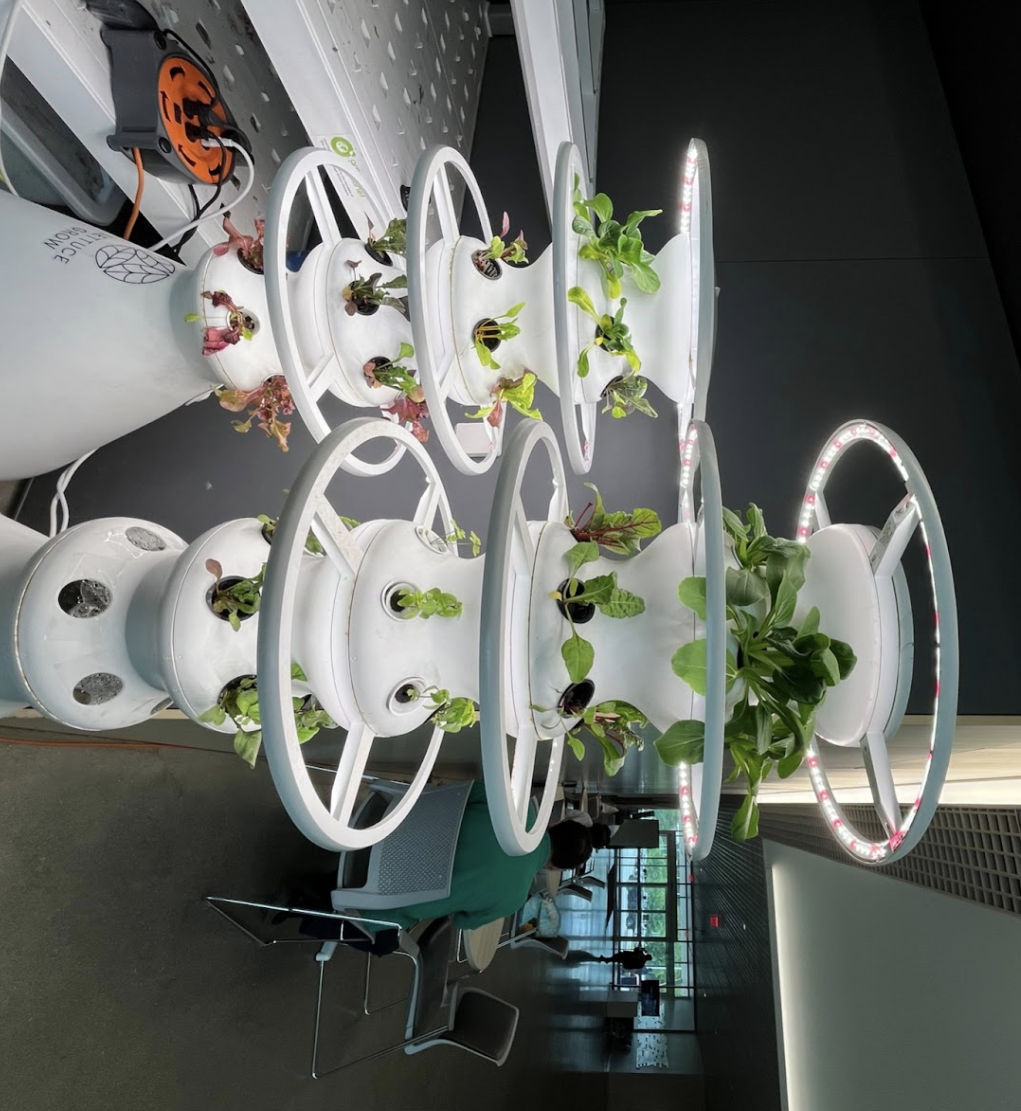
Weinberg third-year Olivia Schenker really loves the earth. The biology and environmental policy and culture major said the environment encompasses her whole life, from going vegan for five years to centering her future career around policy. One way she supports sustainability at Northwestern is through Wild Roots, a student-run garden on Northwestern’s campus.
Schenker is an avid traditional grower with Wild Roots, but along with the other organization members, she will be pivoting toward an innovative form of gardening called hydroponics that Wild Roots is incorporating.
Hydroponics is the technique of growing plants using a water-based nutrient solution rather than soil, according to the USDA National Agricultural Library.
“It’s kind of like a constant flowing water system, and there’s no soil needed,” Schenker said. “The plants are just growing out of the water.”
Rachel Silverman, a McCormick second-year industrial engineering major, is the co-vice president of Engineers Without Borders, a student organization using engineering to promote sustainability. Their newest project is partnering with Wild Roots to build the hydroponic system.
Silverman said hydroponic systems pump water directly to the roots of the plants, which is beneficial for the environment.
“Due to soil degradation, we lose soil faster than we can make it, so having an alternative available when we can grow produce without soil is really essential,” Silverman said. “Second of all, it uses a lot less water than how you would normally grow plants because it doesn’t have to be saturated in the soil and water can be recycled through the system.”
Hydroponic systems work circularly, with water pumping from the nutrient-filled water into the grow tray, and then cycling back to the solution tank where more nutrients are added. The nutrient-water solution is typically replaced every two to three weeks for an average-sized hydroponic structure, according to FloraFlex. An energy source is needed to provide light for the plants when grown indoors and to pump the water.
Engineers Without Borders and Wild Roots are working out these technical details in an effort led by Silverman and Juliana Gonzalez, a McCormick second-year majoring in Manufacturing and Design Engineering. Silverman said she and Gonzalez weren’t familiar with gardening alternatives like hydroponics before Wild Roots reached out, but when the organizations connected, Engineers Without Borders researched the system and decided to take on the project.
“I think you learn a lot more through doing. Joining this club has taught me a lot more about the different solutions that exist,” Silverman said. “[I am] just getting a better grasp of the situation with the environment and the ways we can help.”
Once Engineers Without Borders agreed to collaborate with Wild Roots, they put together a rough design and worked through logistics with Wild Roots advisor Corbin Smyth. Their final sketch is a 6-feet long and 4-feet wide structure with plants growing in horizontal rows above a water basin. While many hydroponic structures feature lights above the plants for controlled growth, this system will not need them because it will receive natural light outdoors.
“They ended up sending us the materials [list] back, and then we redid the materials and sent it back to our advisor, who sent it to SOFO,” Gonzalez said. “The whole process took a really long time. It was very frustrating, honestly.” But the process and patience paid off.
Gonzalez said the students decided to exclusively choose items from Home Depot when rebuilding their materials list because the store is approved on the SOFO platform. While Engineers Without Borders initially planned to unveil the structure in late May 2024, Gonzalez said they are postponing the project launch until the coming academic year due to the delays. She said that even with delays, she thinks a hydroponic system will be meaningful enough for the university that the students are sticking with the plan.
The hydroponic system will bring awareness about water consumption and waste on campus, Gonzalez said. She added that sustainability is a large part of the world now, and integrating it into engineering projects is very interesting to her.
Eric Weber, director of operations at Plant Chicago, embraces and builds upon the sustainable aspects of hydroponics, they said. Plant Chicago, on Chicago’s South Side, adopted hydroponic and aquaponic urban gardens in 2011 when the organization launched. Their first systems were located at The Plant, a former meat processing warehouse welcoming a collaborative community of small food businesses, according to The Plant website. Plant Chicago relocated their hydroponic and aquaponic structures to their current space a few blocks away in 2020, Weber said.
Hydroponics is one component of an aquaponics system, which pumps naturally fertilized water from fish tanks to plants growing in water, then redirects the plant-purified water back to the fish tanks, according to Nelson + Pade. Fish waste fertilizes the water and special bacteria in the water breaks down the ammonia in the waste that would be harmful to plants.
Weber walked through Plant Chicago’s indoor space, which boasts several hydroponic and aquaponic towers of various sizes. In the aquaponic structure, fish swim lazily on the lowest level and a series of pipes lead up to neat rows of plants growing in the water. Weber said the main benefit of aquaponics over hydroponics is that it grows fish in addition to plants.
“You get the ability to have a potential protein source that you can harvest and eat in addition to your veggies,” Weber said. “You treat the system as its own living organism; you’ve got fish, you’ve got plants, you’re trying to keep them living in harmony with each other.”
The nutrient source in a hydroponic system differs significantly from that of an aquaponic system, Weber said. In a solely hydroponic structure, the plants rely on a synthetic fertilizer rather than organically processed fish waste. According to Weber, this ties into one of the main criticisms of hydroponic growth.
Critics of hydroponic growth don’t see hydroponics as organic and instead prefer more natural methods, Weber said. While the U.S. Department of Agriculture (USDA) makes no mention of soil growth in their definition of organic, the USDA does specify that “the basic rule for organic agriculture is to allow natural substances and prohibit synthetic,” according to the website’s Organic 101 subsection. If hydroponic and aquaponic systems do not use synthetic fertilizers, the USDA recognizes them as eligible for organic certification.
But, according to the Real Organic Project, a defining characteristic of organic produce is growth in soil. Weber acknowledged that for both hydroponic and aquaponic growth, the plants grow in a controlled environment rather than letting nature take its course.
“You’re trying to control as many parameters of the environment as possible, so the amount of light, temperature, humidity, airflow, oxygen, CO2…” Weber said. “All that requires technology in some form, which tends to be fairly expensive, and electricity. Depending on your electricity source or part of the world, it can vary in its environmental impact and cost.”
Weber said the “gut check” for these technology-based growth methods is properly weighing cost and energy use against the systems’ benefits. They said some gardeners can build a small in-home hydroponic system for a couple hundred dollars, but the systems can cost upwards of $10,000 depending on size customizations and energy needs. Some structures rely primarily on renewable energy sources, such as the systems at Plant Chicago, which operate from a 16-kilowatt solar array on the roof installed over a year ago, according to Weber. However, others can rack up energy from non-renewable sources such as coal or natural gas, they said.
Opposing organizations such as the Real Organic Project look at the potential cost- and energy-related negatives of hydroponic growth and rule it out as a sustainable option. Weber takes a more holistic approach. They said multiple factors should be considered when implementing hydroponics, such as which crops thrive naturally in that geographical area, which financial resources are available, and whether renewable energy is easily accessible. Hydroponics also recycles water in a world where drought is spreading due to climate change.
“Just as easy as it is to say, ‘Oh, hydroponics is going to save us from world hunger,’ those broad strokes could be used to say, ‘Oh no, this is terrible, it’s a huge waste of space and time and money and electricity,’” Weber said. “I don’t think either of those are right.”
To exemplify their point, Weber said they would never set up huge greenhouses in Florida to grow trees inside because the climate is ideal for growing them naturally outdoors. However, they may consider growing leaf lettuce in Nevada using indoor hydroponics. The state’s desert climate means far more water would be required to irrigate fields than it would be to grow plants in a nutrient-based water solution. They said in that case, the overall water loss is significantly less, which is a clear benefit to growing crops in a desert environment.
Kellye Fleming, branch assistant at the Evanston Public Library’s Robert Crown branch, said hydroponics may not always be sustainable, but offers a great resource nonetheless. She implemented a rental program for hydroponics systems at her branch two years ago, where patrons can rent out small structures for 11 weeks at a time for free.
Hydroponic growing is great for people such as Fleming who live in apartments and don’t have much access to greenspace, she said. She added that soil can contain lead or other heavy metals in urban areas, making it impossible to grow healthy crops. Indoor hydroponic growth makes fresh produce more accessible in that circumstance and for growing greens and herbs off-season. Flemings said she doesn’t rule out the benefits of hydroponics simply because it’s not considered organic.

“If you are sustainability growing items, does it matter if it’s organic?” Fleming said. “As long as people are growing, it’s great.”
Schenker also frowns upon black-and-white criticism of hydroponic systems. To her, everything has a positive and negative, she said, and giving people more options for plant growth in different situations is a move in the right direction.
“I’m not saying that we should completely move toward hydroponics — I think that would be unsustainable,” Schenker said. “But when it comes to how little access to good, clean food people have nowadays, a diverse amount of solutions to implement is great.”
The hydroponic system created by Engineers Without Borders and Wild Roots will tentatively be placed outside Norris University Center in 2025.
Silverman said the system will feature a QR code with information about hydroponics so students can learn more about why this structure was built. She thinks the project will spark interest in the environment on campus, she said.
“I hope it draws curiosity toward sustainability-focused tools,” Silverman said. “I want it to open the conversation about other ways we can be more environmentally conscious.”